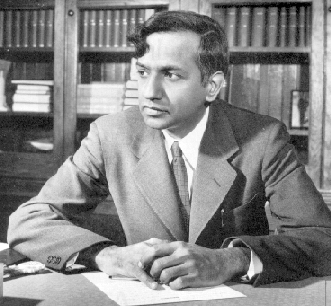[/caption]
When a human puts on too much weight, there is an increased risk of heart attack; when a white dwarf star puts on too much weight (i.e. adds mass), there is the mother of all fatal heart attacks, a supernova explosion. The greatest mass a white dwarf star can have before it goes supernova is called the Chandrasekhar limit, after astrophysicist Subrahmanyan Chandrasekhar, who worked it out in the 1930s. Its value is approx 1.4 sols, or 1.4 times the mass of our Sun (the exact value depends somewhat on the white dwarf’s composition how fast it’s spinning, etc).
White dwarfs are the end of the road for most stars; once they have used up all their available hydrogen ‘fuel’, low mass stars shed their outermost shells to form planetary nebulae, leaving a high density core of carbon, oxygen, and nitrogen (that’s a summary, it’s actually a bit more complicated). The star can’t collapse further because of electron degeneracy pressure, a quantum effect that comes from the fact that electrons are fermions (technically, only two fermions can occupy a given energy state, one spin up and one spin down).
So what happens in the core of a massive star, one whose core weighs in at more than 1.4 sols? As long as the star is still ‘burning’ nuclear fuel – helium, then carbon etc, then neon, then … – the core will not collapse because it is very hot (electron degeneracy pressure won’t hold it up ’cause it’s too massive). But once the core gets to iron, no more burning is possible, and the core will collapse, spectacularly, producing a core collapse supernova.
There is a way a white dwarf can go out with a bang rather than a whimper; by getting a little help from a friend. If the white dwarf has a close binary companion, and if that companion is a giant star, some of the hydrogen in its outer shell may end up on the white dwarf’s surface (there are several ways this can happen). The white dwarf thus adds mass, and every so often the thin hydrogen envelope blows up, and we see a nova. One day, though, the extra mass may put it over the limit, the Chandrasekhar limit … the temperature in its center gets high enough that the carbon ‘ignites’, the ‘flame’ spreads throughout the star, and it becomes a special kind of supernova, a Ia supernova.
For more technical details of the Chandrasekhar limit, Richard Fitzpatrick of the University of Texas at Austin has an online Thermodynamics & Statistical Mechanics course, which includes a page on the Chandrasekhar limit.
Supernovae are very important to astronomy, so you won’t be surprised to learn that there are lots of Universe Today stories on the Chandrasekhar limit! Some examples: White Dwarf Theories Get More Proof, White Dwarf “Close” to Exploding as Supernova, and Colliding White Dwarfs Caused a Powerful Supernova.
Astronomy Cast Episode 90 (The Scientific Method) includes a look at how Chandrasekhar worked out the limit that now bears his name, and Where Do Stars Go When They Die? also covers this topic.
References:
Wikipedia
http://www.bluffton.edu/~bergerd/NSC_111/stars.html

